#Ranatra
Text

Found this strange bug in a bucket of water, its apparently a water stick insect, a ranatra. Never seen this before!
0 notes
Text
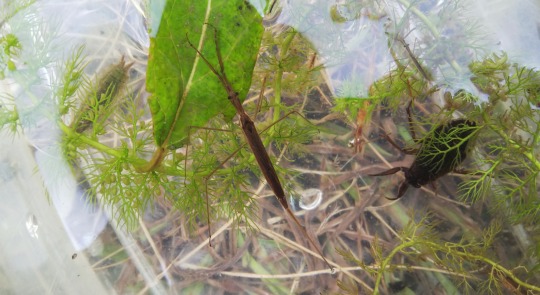
Ranatra unicolor
ヒメミズカマキリ
体長:約30mm (呼吸管除く)
分布:北海道〜南西諸島
RDB:ー
小型のミズカマキリで、全長に占める呼吸管の長さもミズカマキリに比べて短い。
ヒシやジュンサイ等の浮葉植物や、カンガレイ等の抽水植物の多い池沼に生息する。
1 note
·
View note
Text
part of being an entomology major really is just finding out about weird bugs you've never heard of before and going "wow that's awesome!! who let this happen"
#clamtalk#this post is about water scorpions do not derail#Specifically the ranatra species#Not the giant water bugs. I know them. Me and them go way back.#i mean the water stick insects. Hello?#they look like someone's attempt at making a mantis but forgetting many other crucial elements of mantids#and wanting to combine them with a stick bug really bad#but instead of settling on it being a mantis or a stick bug. Or even mantophasmotodea.#They went ''hmmmmm...... Nah. Put a rostrum on that beast!!!! Make it a hemiptera :)''#what happened here ........#entomology#bugposting
38 notes
·
View notes
Photo

Common Water Stick Insect (Ranatra linearis)
Family: Water Scorpion Family (Nepidae)
IUCN Conservation Status: Unassessed
Although its name and elongated, stick-like body may suggest otherwise, the Common Water Stick Insect is not closely related to true stick insects, instead being a highly specialized species of water scorpion (a family of aquatic, carnivorous insects characterised by their hooked front legs which, like the legs of a mantis, are modified to be used for grasping prey.) Although its stick-like body has developed independently of the true stick insects found on land, it is used for a similar purpose - like most stick insects, Common Water Stick Insects spend much of their lives perched motionless on branches or other forms of submerged vegetation, making them difficult to distinguish from the plants around them. Remaining in this position conceals them both from potential predators and from their prey, and when a suitably sized animal (usually a large aquatic insect, tadpole or small fish) gets close enough they use their powerful hook forelimbs to quickly grasp and restrain it before inserting their sharp-tipped, tube-like mouths and draining the prey of nutritious internal fluids such as blood or haemolymph (the equivalent of blood in arthropods.) Found in well vegetated ponds, lakes and (on rare occasions) lagoons across much of Europe and North America, Common Water Stick Insects move between perches by swimming, but are unable to extract oxygen from water and must instead keep the long, tail-like protrusion at the tip of their abdomen, which essentially serves as a rear-mounted organic snorkel, above the surface when perching in order to breathe. Members of this species breed in the mid spring (with females depositing a large number of tiny eggs in neat rows on aquatic vegetation shortly afterwards,) and their larvae, which are carnivorous from birth, reach full maturity when around 2 months old. Though they rarely leave the water if left to their own devices, a lack of prey may lead to large numbers of Common Water Stick Insects surfacing and taking flight in search of new hunting grounds.
--------------------------------------------------------------------------
Image Source: https://www.inaturalist.org/taxa/362340-Ranatra-linearis
#Common Water Stick Insect#Water stick insect#insect#insects#zoology#biology#entomology#arthropods#arthropod#north american wildlife#european wildlife#aquatic wildlife#pond wildlife#bug#bugs
49 notes
·
View notes
Text
Should I purchase...
A water scorpion (Ranatra sp.)
A black hole spider (Kukulcania arizonica)
A colony of bess beetles (Passalidae sp.)
A group of striped diving beetles (Thermonectus nigrofasciatus)
A Mojave spiny flower mantis (Pseudocreobotra wahlbergi)
15 notes
·
View notes
Text
Today’s atrocity that the world has decided it’s ok to live is the Brown water scorpion or the ranatra fusca if your a prick. It’s a fucking scorpion in the water. Have fun swimming next time you’re in the water. 

Have a horrible day!!! <3
6 notes
·
View notes
Text
Just spent the last hour and a half trudging through shin height muck looking for ranatra
I love my job so much 🥹
0 notes
Photo

Montezuma Well in Rimrock, Arizona
This desert watering hole has seen activity for thousands of years. Like its partner, the nearby Montezuma Castle, its name has nothing to do with the famous Aztec emperor, but everything to do with early European/American mistaken assumption that he had something to do with the area. The part of Arizona where Montezuma Well sits has been inhabited by a number of groups over time, dating back as far as 10,000 years. You can find ruins of cliff dwellings around the rim of the well, which were inhabited by the Sinagua people between the 12th and 15th centuries. But the history of this desert water features dates back much further than that. About 12 million years ago, the Verde Valley was covered by a large shallow lake. After that lake dried up about 2 million years ago, leaving behind a bed of thick limestone. Over the years, underground streams carved out caverns within that stone. Montezuma Well is one of those caverns—when the layer of rock at the surface crumbled, it became a sinkhole. Its opening measures 368 feet across, and more than a million gallons of water flow through it every day. The water in Montezuma Well is heavily carbonated and contains significant levels of arsenic, neither of which lend themselves to a thriving fish population. But the unique environment of this watering hole supports several species that are found nowhere else in the world, including a water scorpion (Ranatra montezuma) that feeds on the amphipods found in the water, a leech (Motobdella montezuma), and a tiny freshwater mollusk called the Montezuma Well springsnail (Pyrgulopsis montezumensis). Some say that whatever exits the well, can never return. In 2006, the National Park Service sent divers into the water. They sent probes, cameras, and other equipment down and learned that what appeared to be the bottom of the well was actually a column of "fluidized sand" that more than doubled the estimated depth of the well.
https://www.atlasobscura.com/places/montezuma-well-arizona
0 notes
Photo
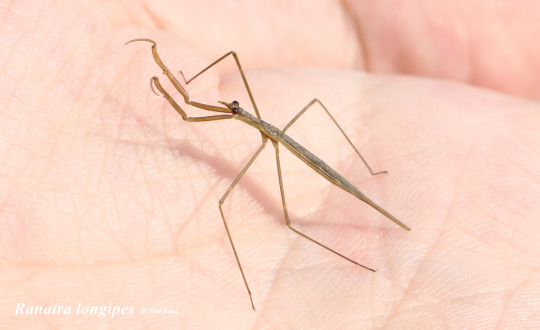
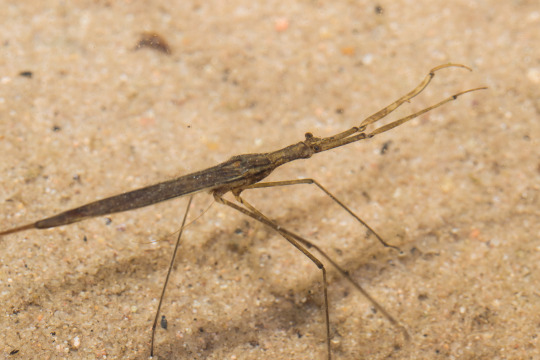

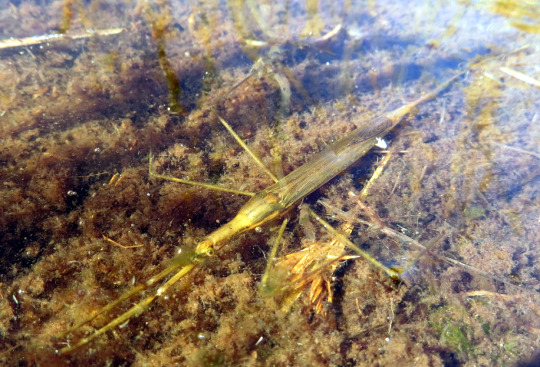

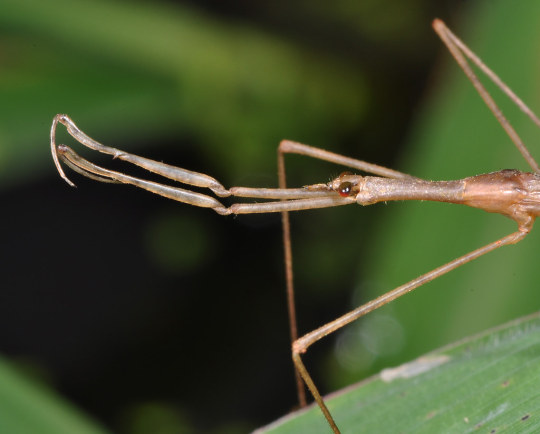
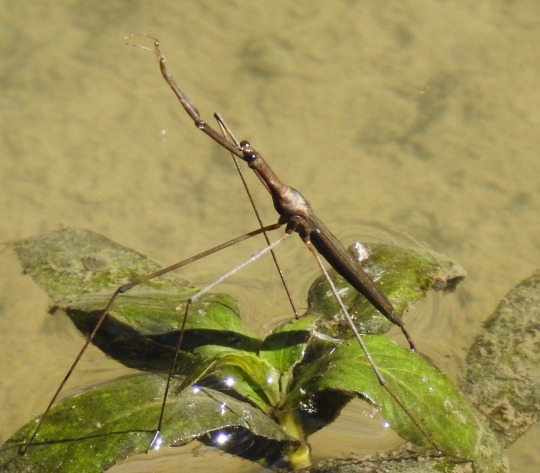

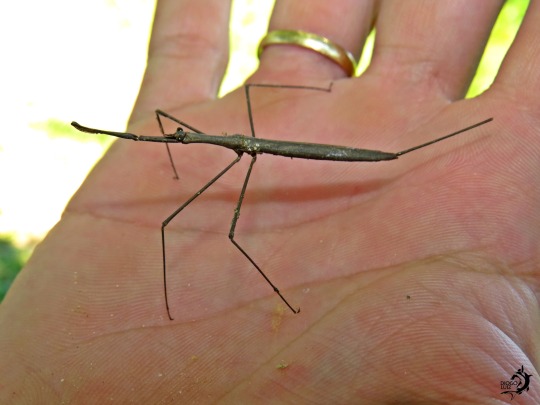
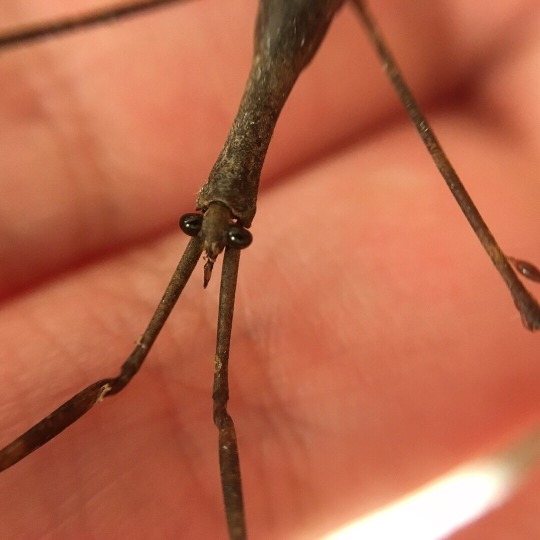
Waterscorpions in the genus Ranatra, Nepidae, Hemiptera
Waterscorpions (sometimes called water stick insects) are predatory, freshwater true bugs found throughout the world. Their raptorial front limbs are used for grasping prey, which includes other insects, tadpoles, and even small fish. They breathe air through a tail-like siphon on their rear end. Despite their almost exclusively aquatic lifestyle, they can and will fly, but do so rarely.
Photo 1 by zhongyankui, 2-3 by wenzel_sylvester, 4 by gijwans, 5-6 by Art Anker (shared with permission; do not remove credit or re-post!), 7 by vanremsen, 8 by josh_vandermeulen, 9 by diogoluiz, and 10 by hazelsnail
#animals#curators on tumblr#insects#bugs#waterscorpion#water stick insect#Nepidae#true bugs#aquatic#Ranatra#one nice bug#you have no idea how hard it was not to call their siphon a butt snorkel
933 notes
·
View notes
Text
I can’t believe how wonderful the faces on water scorpions are

I mean look at this fuckin dude
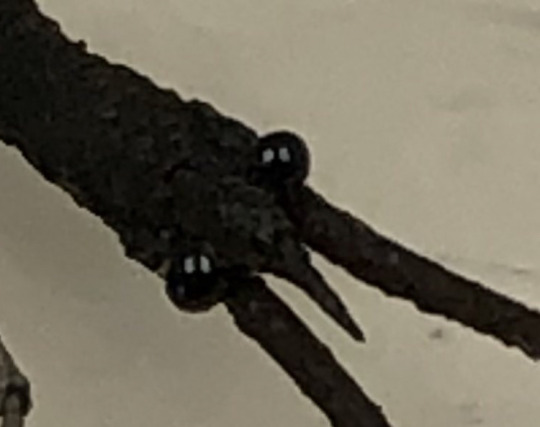
🥺
4K notes
·
View notes
Video
youtube
Ранатра палочковидная из семейства водяных скорпионов. Крым. Ranatra. In...
#ранатра#насекомое#насекомые крыма#Крымское насекомое#фауна Крыма#хищное насекомое#хищник#клоп#огромный клоп#летающее насекомое#редкое насекомое#исчезающее насекомое#водяной скорпион#подводное насекомое#Ranatra#insect#water insect#water bug#crimea insect#water stick#large bug#rare insect#endangered species#predator#predatory insect
0 notes
Photo
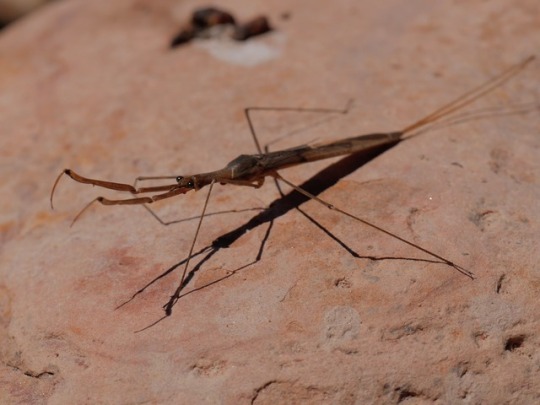
Ranatra fusca “Brown Waterscorpion” Nepidae
Lake Inez, Lolo National Forest, MT
May 23, 2017
Robert Niese
There’s something genuinely unnerving about insects viciously preying upon vertebrates, and waterscorpions are superbly specialized for this terrifying task. They sit near the surface of the water, head down, with their elongated, raptorial front limbs outstretched, waiting. Their long paired “tails” remain in contact with the water’s surface like a snorkel, allowing them to breathe while fully submerged. When some unlucky fish or tadpole swims too close, they snap them up like a mantis and immediately stab them with their sucking mouthparts. Their saliva both subdues and begins to digest their prey, allowing them to suck out the animal’s insides. On a completely unrelated note, this individual looks worse for wear, which led me to discover that adults actually overwinter in lakes and ponds here in Montana -- not an easy task considering that most bodies of water freeze-over completely at some point. So apparently they’re indestructible AND hyper-specialized predators. Thank goodness they’re only five inches long.
#Ranatra fusca#Ranatra#Nepidae#Waterscorpion#Brown Waterscorpion#Hemiptera#true bugs#Lake Inez#Lolo National Forest#Montana#Pacific Northwest#macro photography#original photography#photographers on tumblr#natural history#Robert Niese
90 notes
·
View notes
Text
PREDATORY EFFICIENCY OF FRESHWATER BUGS Diplonychus indicus VENK. & RAO (HEMIPTERA: BELOSTOMATIDAE) AND Ranatra filiformis FABRICIUS (HEMIPTERA: NEPIDAE) ON THE LARVAE OF THE DENGUE VECTORS Aedes aegypti LINNAEUS AND Aedes albopictus SKUSE (DIPTERA: CULICIDAE) | UTTAR PRADESH JOURNAL OF ZOOLOGY
Because of its environmentally friendly nature, the use of biological agents for mosquito control is critical. Under laboratory simulated natural conditions, the predatory potential of Diplonychus indicus and Ranatra filiformis was tested on third instar larvae of dengue vectors, Aedes aegypti and Aedes albopictus, as prey for three days. The predatory effect and clearance rate were computed, as well as the mutual interference constant between predators when various numbers of predators were calculated using the clearance rate data. Diplonychus indicus and Ranatra filiformis had predatory impact values of 17.3 to 20.0 and 17.8 to 19.2 against Aedes aegypti, respectively, and 16.8 to 20.6, and 14.6 to 15.9 against Aedes albopictus. The predatory effect did not differ between the two predator species and the two prey species, nor did the interaction between them, though Diplonychus indicus had a pintsized advantage. The clearance rates for Diplonychus indicus and Ranatra filiformis against Aedes aegypti were 2.5 to 2.8 and 2.1 to 2.5, respectively, while Aedes albopictus clearance rates were 1.2 to 1.8 and 1.4 to 2.0. The clearance rates did not differ by predator species or days, though there was a small difference on Day 2. Diplonychus indicus and Ranatra filiformis successfully consumed dengue larvae, and the rate of consumption differed only slightly between the two predators, which could be due to differences in the predators' life histories and characteristics, and thus play an important role in the regulation of dengue larval mosquito populations.
Please see the link :- https://mbimph.com/index.php/UPJOZ/article/view/1873
#Diplonychus indicus#Ranatra filiformis#Aedes aegypti#Aedes albopictus#predatory impact#clearance rate
0 notes
Photo
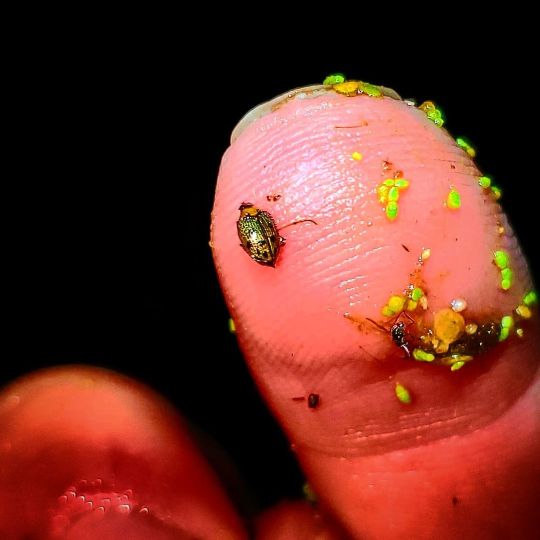
This is the 77th installment of 'Since I've Been Gone'. Taken on the same night of the last post while on my Iowa hitch with @americanconservationexperience, I caught this tiny crawling water beetle that I believe is 'Peltodytes edentulus', but if someone wants to correct me, be my guest. Like others of their family, they are clumsy swimmers compared to driving beetles, not to mention not as well studied, which is surprising given how great they are to look at. #animal #animals #wildlife #iowawildlife #nature #iowanature #invertebrate #invertebrates #fauna #imago #iowainsects #insect #insects #insectagram #aquaticinsect #aquaticinsects #beetle #beetles #waterbeetle #crawlingwaterbeetle #crawlingwaterbeetles #animalia #arthropod #arthropods #arthropoda #insecta #hemiptera #nepidae #ranatra #ranatrafusca (at YMCA Camp Wapsie) https://www.instagram.com/p/CWMVBXxKCFP/?utm_medium=tumblr
#animal#animals#wildlife#iowawildlife#nature#iowanature#invertebrate#invertebrates#fauna#imago#iowainsects#insect#insects#insectagram#aquaticinsect#aquaticinsects#beetle#beetles#waterbeetle#crawlingwaterbeetle#crawlingwaterbeetles#animalia#arthropod#arthropods#arthropoda#insecta#hemiptera#nepidae#ranatra#ranatrafusca
2 notes
·
View notes
Text
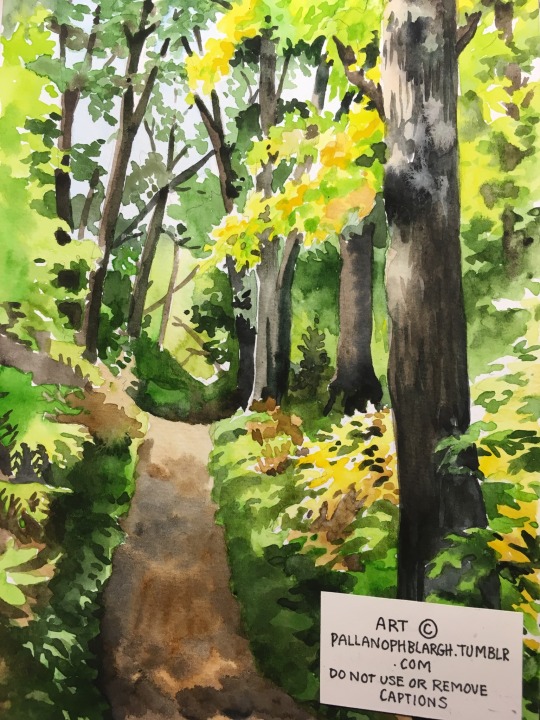

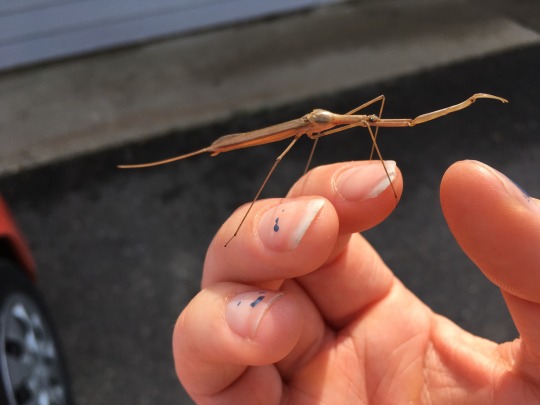

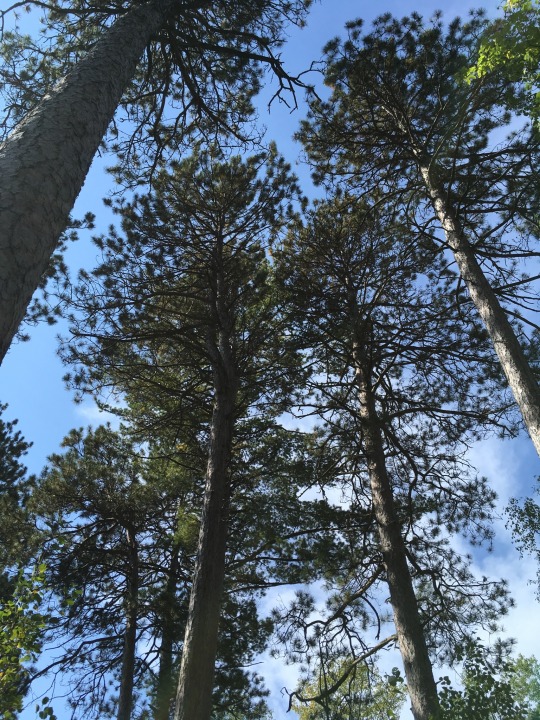


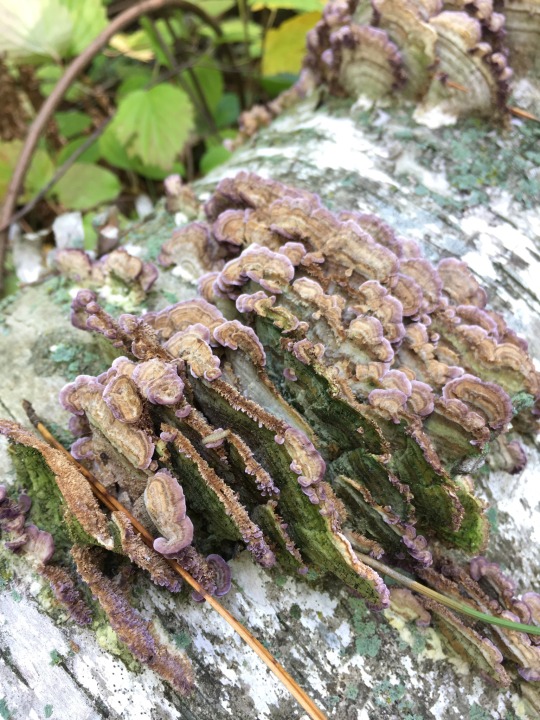


Back from an extremely short camping trip to Lake Itasca. Had to leave out a lot of my regular habits (long solitary trail walks and plein air painting) but had a good time with friends and new people, as well as tried out new activities: rented a kayak despite never having used one and it turns out I’m not terrible at it. Went up the fire tower there, saw an even better than usual view and managed to not lose my cool due to fear of heights.
Also made “friends” with plenty of critters. I’m sure the wood froglet couldn’t wait for us to stop admiring it, but the yellowjackets and honeybees were VERY interested in us and were convinced we were protein/hiding very tasty sugary goodness. Yes I let them land on my face. I’m entertained and unharmed. (Yellowjackets and I have always been on exceptionally good terms.)
Also first time seeing a “water scorpion,” (ranatra fusca?) that I initially thought was a confused stick insect. It hitched a ride in our car but flew off on its merry way after I admired it for a bit.
Despite the lack of time to do proper on location painting, I did a quick study from a photo to ease my sorrow at having to leave too soon. I think it turned out quite well! (Improvement?!?) Will be doing more, I have plenty of material to use.
#itasca state park#lake itasca#watercolor#scenery#forest#woods#nature#landscape photography#insect#bug#yellowjacket wasp#wood frog#violet toothed polypore#white pine#red pine#still love my pines so damn much#you could say im a sap#still my favorite state park?#still sad i couldnt hit up my usual haunts
469 notes
·
View notes
Text
I got a Rànatra Fusca, its crazy, like holy fuck, I'm *DEAD* and no one outside odyssey is going to understand, but just Im amazed, I was nominated by 2 teams who were competing against me, I got a standing ovation from the judges I'm not trying to gloat, Im just literally in shock and probably will continue to be for the next 5 years and theres something incredible about getting it my senior year, like idk, the whole situation is just so surreal
28 notes
·
View notes